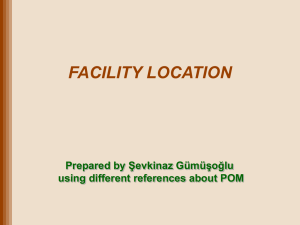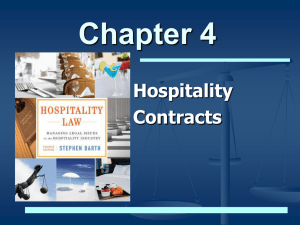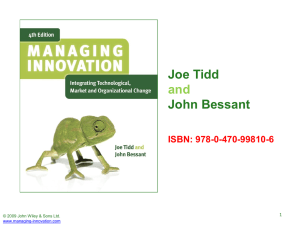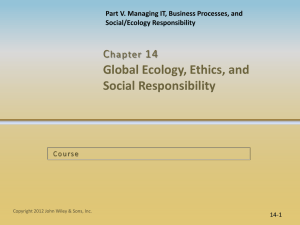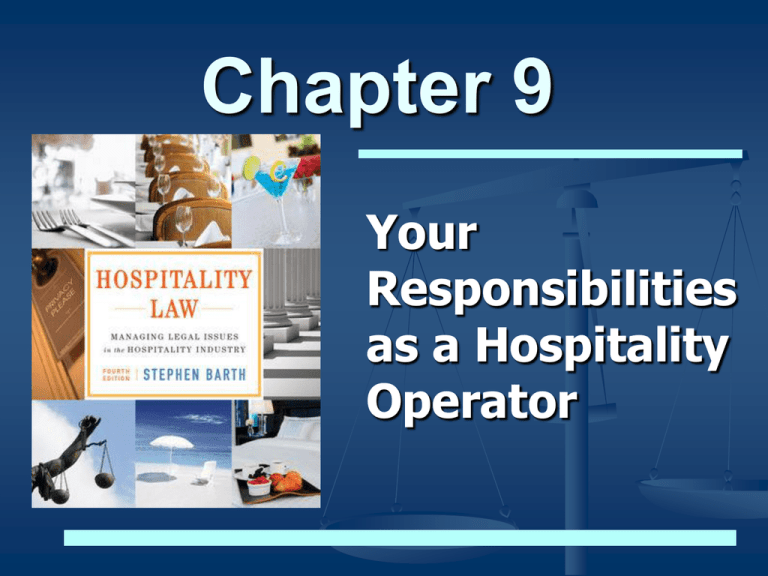
Chapter 9
Your
Responsibilities
as a Hospitality
Operator
Your Responsibilities as a
Hospitality Operator
Duties And Obligations Of A Hospitality
Operator
Theories Of Liability
Legal Damages
Anatomy Of A Personal Injury Lawsuit
Responding To An Incident
© 2012 Stephen C. Barth P.C. and John Wiley & Sons, Inc.
All Rights Reserved
In This Chapter, You Will Learn:
1.
2.
To differentiate between the types of
legal duties required of a hospitality
operator, and the consequences of the
failure to exercise reasonable care in
fulfilling these duties.
To evaluate operational activities in light
of their impact on guest safety and
potential legal damages.
© 2012 Stephen C. Barth P.C. and John Wiley & Sons, Inc.
All Rights Reserved
In This Chapter, You Will Learn:
3.
4.
To understand how a lawsuit is initiated
and moves through the U.S. court
system.
To create a checklist of the steps that
should be initiated immediately following
an accident.
© 2012 Stephen C. Barth P.C. and John Wiley & Sons, Inc.
All Rights Reserved
Duties and Obligations of a
Hospitality Operator
Legalese:
Duty of Care - A legal obligation to protect
against harm.
© 2012 Stephen C. Barth P.C. and John Wiley & Sons, Inc.
All Rights Reserved
Duties of Care
1.
2.
3.
4.
Provide a reasonably safe premise.
Serve food and beverages fit for
consumption.
Serve alcoholic beverages responsibly.
Hire qualified employees.
© 2012 Stephen C. Barth P.C. and John Wiley & Sons, Inc.
All Rights Reserved
Duties of Care
5.
6.
7.
8.
Properly train employees.
Terminate employees who pose a danger
to other employees or the guest.
Warn of unsafe conditions.
Safeguard guest property, especially
when voluntarily accepting possession of
it.
© 2012 Stephen C. Barth P.C. and John Wiley & Sons, Inc.
All Rights Reserved
Analyze the Situation 9.1
Alan Brandis arrived at the Golden Fox
restaurant for a Friday night fish fry. During his
meal, a severe thunderstorm began, which
caused the ceiling of the men's restroom to leak.
After finishing his meal, Alan entered the men's
room to wash his hands. He slipped on some
wet tile, which was caused by the leak in the
roof. Alan struck his head during the fall, and
was severely injured.
© 2012 Stephen C. Barth P.C. and John Wiley & Sons, Inc.
All Rights Reserved
Analyze the Situation 9.1
One week later, Mr. Brandis's attorney
contacted the owners of the Golden Fox
with a claim for damages. The restaurant
owners maintained the fall was not their
responsibility, claiming they were not the
insurers of guest safety. While the owners
knew of the condition of the roof, they said
it leaked only during extremely heavy
thunderstorms and was too old to fix
without undue economic hardship.
© 2012 Stephen C. Barth P.C. and John Wiley & Sons, Inc.
All Rights Reserved
Analyze the Situation 9.1
Most important, because the storm was not
within their control, the owners maintained
that it was not reasonable to assume they
could have foreseen the severity of the storm,
and thus could not be held liable for the
accident.
© 2012 Stephen C. Barth P.C. and John Wiley & Sons, Inc.
All Rights Reserved
Analyze the Situation 9.1
1.
2.
3.
4.
Was the severity of the storm a
foreseeable event?
What duty of care is in question here?
Did the restaurant act prudently?
Are the restaurant's defenses valid? Why
or why not?
© 2012 Stephen C. Barth P.C. and John Wiley & Sons, Inc.
All Rights Reserved
Duties and Obligations of a
Hospitality Operator
Legalese:
Standard of Care - The industry-
recognized, reasonably accepted level
of care used in fulfilling a Duty of Care.
© 2012 Stephen C. Barth P.C. and John Wiley & Sons, Inc.
All Rights Reserved
Theories of Liability
Legalese:
Reasonable Care - The degree of care that
a reasonably prudent person would use
in a similar situation.
© 2012 Stephen C. Barth P.C. and John Wiley & Sons, Inc.
All Rights Reserved
Theories of Liability
Legalese:
Tort - An act or failure to act (not
involving a breach of contract), that
results in injury, loss or damage to
another (i.e. negligence is an
unintentional tort; whereas battery,
physically touching someone is usually
an intentional tort).
© 2012 Stephen C. Barth P.C. and John Wiley & Sons, Inc.
All Rights Reserved
Theories of Liability
Legalese:
Negligent (Negligence) - The failure to use
reasonable care.
© 2012 Stephen C. Barth P.C. and John Wiley & Sons, Inc.
All Rights Reserved
Theories of Liability
Legalese:
Proximate Cause - The event or activity
that directly contributes to (causes),
the injury or harm.
© 2012 Stephen C. Barth P.C. and John Wiley & Sons, Inc.
All Rights Reserved
Theories of Liability
Legalese:
Gross Negligence - The reckless or willful
failure of an individual or an
organization to use even the slightest
amount of reasonable care.
© 2012 Stephen C. Barth P.C. and John Wiley & Sons, Inc.
All Rights Reserved
Analyze the Situation 9.2
Paul and Beatrice Metz took their 11year-old daughter Christine on a weekend
skiing trip and stayed at the St. Stratton
ski resort. The St. Stratton owned and
maintained four ski trails and a ski lift on
its property.
© 2012 Stephen C. Barth P.C. and John Wiley & Sons, Inc.
All Rights Reserved
Analyze the Situation 9.2
One morning, Mr. and Mrs. Metz were having
coffee in the ski lodge while their daughter was
riding the ski lift to the top of the mountain. On
the way up, the car containing Christine Metz
and one other skier jumped off its cable guide
and plunged 300 feet down the mountain. As a
result of the fall, Christine was permanently
paralyzed from the neck down.
© 2012 Stephen C. Barth P.C. and John Wiley & Sons, Inc.
All Rights Reserved
Analyze the Situation 9.2
The Metzs filed a lawsuit against the resort.
Their attorney discovered that the car's
connections to the cable were checked once a
year by a maintenance staff person unfamiliar
with the intricacies of ski cable cars. The
manufacturer of the cable car recommended
weekly inspections, performed by a specially
trained service technician.
© 2012 Stephen C. Barth P.C. and John Wiley & Sons, Inc.
All Rights Reserved
Analyze the Situation 9.2
The ski resort's corporate owners maintained
that all skiers assumed risk when skiing, that the
manufacturer's recommendation was simply a
recommendation, and that their own inspection
program demonstrated they had indeed
exercised reasonable care. In addition, they
maintained that Christine's paralysis was the
result of an unfortunate accident for which the
cable car's manufacturer, and not the resort,
should be held responsible.
© 2012 Stephen C. Barth P.C. and John Wiley & Sons, Inc.
All Rights Reserved
Analyze the Situation 9.2
1.
2.
3.
4.
Did the resort exercise reasonable care?
What level of negligence, if any, was present?
Ordinary negligence? Gross negligence?
What amount of money do you think a jury
would recommend the resort be required to
pay to compensate Christine Metz for her loss,
if it is found to have committed a tort against
her?
Are the resort's defenses valid ones? Why or
why not?
© 2012 Stephen C. Barth P.C. and John Wiley & Sons, Inc.
All Rights Reserved
Theories of Liability
Legalese:
Contributory Negligence - Negligent
conduct by the complaining party
(plaintiff) that contributes to the cause
of his or her injuries.
© 2012 Stephen C. Barth P.C. and John Wiley & Sons, Inc.
All Rights Reserved
Theories of Liability
Legalese:
Comparative Negligence - Shared
responsibility for the harm that
results from negligence. The
comparison of negligence by the
defendant with the contributory
negligence of the defendant. (Also
known as comparative fault.)
© 2012 Stephen C. Barth P.C. and John Wiley & Sons, Inc.
All Rights Reserved
Theories of Liability
Legalese:
Strict Liability - Responsibility arising
from the nature of a dangerous activity
rather that negligence or an intentional
act. (Also known as absolute liability
or liability without fault.)
© 2012 Stephen C. Barth P.C. and John Wiley & Sons, Inc.
All Rights Reserved
Search the Web 9.1
Go to: www.findlaw.com.
1.
Select: “Accidents & Injuries” in the Individual
Issues section under Learn About the Law.
2.
Type: Your state and city in the Location field.
3.
Select: Find Lawyers
a)
b)
Select the name of an attorney practicing in a geographic
area in which you have an interest.
Contact the attorney’s office by telephone or letter and
ask if they can help you understand how the state and/or
local courts view comparative negligence in their practice
area via information on a web site address or in a
publication.
© 2012 Stephen C. Barth P.C. and John Wiley & Sons, Inc.
All Rights Reserved
Theories of Liability
Legalese:
Intentional Act - A willful action
undertaken with or without full
understanding of its consequences.
© 2012 Stephen C. Barth P.C. and John Wiley & Sons, Inc.
All Rights Reserved
Intentional Acts of Third Parties
Forseeability
Reasonable care
© 2012 Stephen C. Barth P.C. and John Wiley & Sons, Inc.
All Rights Reserved
Theories of Liability
Legalese:
Negligence Per Se - When a rule is
violated by the operator; such violation
of a rule is considered to be far outside
the scope of reasonable behavior that
the violator is assumed to be negligent.
© 2012 Stephen C. Barth P.C. and John Wiley & Sons, Inc.
All Rights Reserved
Legal Damages
Legalese:
Compensatory Damages - Are awarded to
restore the injured party to the position
they were in prior to the injury (i.e.
medical expenses, lost wages, etc.).
© 2012 Stephen C. Barth P.C. and John Wiley & Sons, Inc.
All Rights Reserved
Legal Damages
Legalese:
Punitive Damages - A monetary amount
used as punishment and to deter the
same wrongful act in the future by the
defendant and others.
© 2012 Stephen C. Barth P.C. and John Wiley & Sons, Inc.
All Rights Reserved
Anatomy of a Personal Injury
Lawsuit
Legalese:
Personal Injury - Damage or harm inflicted
upon the body, mind or emotions.
© 2012 Stephen C. Barth P.C. and John Wiley & Sons, Inc.
All Rights Reserved
Anatomy of a Personal Injury
Lawsuit
Demand Letter
Petition
Discovery
Trial and Appeal
© 2012 Stephen C. Barth P.C. and John Wiley & Sons, Inc.
All Rights Reserved
Anatomy of a Personal Injury
Lawsuit
Legalese:
Demand Letter - Official notification,
typically delivered to a defendant via
registered or certified mail, that details
the plaintiff’s case for impending
litigation.
© 2012 Stephen C. Barth P.C. and John Wiley & Sons, Inc.
All Rights Reserved
Anatomy of a Personal Injury
Lawsuit
Legalese:
Contingency Fee - A method of paying for
a civil attorney’s services where the
attorney receives a percentage of any
money awarded as a settlement in the
case. Typically, these fees range from
20-40% of the total amount awarded.
© 2012 Stephen C. Barth P.C. and John Wiley & Sons, Inc.
All Rights Reserved
Anatomy of a Personal Injury
Lawsuit
Legalese:
Interrogatories - Questions which require
written answers, given under oath,
asked during the discovery phase of a
lawsuit.
© 2012 Stephen C. Barth P.C. and John Wiley & Sons, Inc.
All Rights Reserved
Anatomy of a Personal Injury
Lawsuit
Legalese:
Depositions - Oral answers, given under
oath, to questions asked during the
discovery phase of a lawsuit.
Depositions are recorded by a certified
court reporter and/or by videotape.
© 2012 Stephen C. Barth P.C. and John Wiley & Sons, Inc.
All Rights Reserved
Anatomy of a Personal Injury
Lawsuit
Legalese:
Subpoena – A court-authorized order to
appear in person at a designated time
and place, or to produce evidence
demanded by the court.
© 2012 Stephen C. Barth P.C. and John Wiley & Sons, Inc.
All Rights Reserved
Anatomy of a Personal Injury
Lawsuit
Legalese:
Appeal - A written request to a higher
court to modify or reverse the decision
of a lower level court.
© 2012 Stephen C. Barth P.C. and John Wiley & Sons, Inc.
All Rights Reserved
Alternative Dispute Resolution
Arbitration
Mediation
© 2012 Stephen C. Barth P.C. and John Wiley & Sons, Inc.
All Rights Reserved
Search the Web 9.2
Log on to the Internet and enter www.spidr.org.
1.
Select: Ethical Standards of Professional
Responsibility.
2.
Review the document developed by the Society for
Professionals in Dispute Resolution (SPIDR).
3.
From the document displayed, determine:
a)
b)
What are the major responsibilities to the parties
addressed in the Society’s Ethical Statement?
Which responsibility do you believe is most
important for effective mediation? Why?
© 2012 Stephen C. Barth P.C. and John Wiley & Sons, Inc.
All Rights Reserved
Responding to an Accident
Step 1 - Do call 911.
Step 2 - Do attend to the injured party.
Step 3 - Do be sensitive and sincere.
Step 4 - Do not apologize for the accident.
Step 5 - Do not admit that you or your
employees were at fault. Do not take
responsibility for that accident.
© 2012 Stephen C. Barth P.C. and John Wiley & Sons, Inc.
All Rights Reserved
Responding to an Accident
Step 6 - Do not offer to pay for the
medical expenses of the injured party.
Step 7 - Do not mention insurance
coverage.
Step 8 - Do not discuss the cause of the
accident.
© 2012 Stephen C. Barth P.C. and John Wiley & Sons, Inc.
All Rights Reserved
Responding to an Accident
Step 9 - Do not correct the employee at
the scene.
Step 10 - Do a complete and through
investigation.
Step 11 - Do complete a claim report, and
submit it to your insurance company
immediately.
© 2012 Stephen C. Barth P.C. and John Wiley & Sons, Inc.
All Rights Reserved
Responding to an Accident
Step 12 - Do not discuss the
circumstances surrounding the accident or
the investigation with anyone except those
who absolutely need to know.
Step 13 - Do not throw away records,
statements, or other evidence until the
case is finalized.
© 2012 Stephen C. Barth P.C. and John Wiley & Sons, Inc.
All Rights Reserved
What Would You Do?
Assume you are a mediator whose job
is to help opposing parties limit the
expense and time of going to trial in
matters of personal injury. In your current
case, Jeremy and Anne Hunter have filed
a personal injury suit against the Fairview
Mayton Hotel’s ownership group and its
franchisor, Mayton Hotels and Resorts Inc.
© 2012 Stephen C. Barth P.C. and John Wiley & Sons, Inc.
All Rights Reserved
What Would You Do?
According to the Hunters, they checked into
their suite at the Fairview Mayton, one of 150
independently owned, franchise-affiliated
properties, on a Friday night. Their daughter
Susan, who was 8 years old at the time, opened
a sliding patio door, and upon seeing the
outdoor hot tub that was part of suite, asked her
parents if she could get in. They told her yes.
© 2012 Stephen C. Barth P.C. and John Wiley & Sons, Inc.
All Rights Reserved
What Would You Do?
Upon entering the tub (it is agreed by both
parties that Susan “jumped” into the hot tub),
she suffered third-degree burns over 80 percent
of her body, and her facial features were
permanently disfigured because the water in the
hot tub was 160 degrees F., not 102, the
maximum recommended by the tub’s
manufacturer, and well above the 105-degree
maximum dictated by local health codes.
© 2012 Stephen C. Barth P.C. and John Wiley & Sons, Inc.
All Rights Reserved
What Would You Do?
An investigation determined that the hot tub
safety switch, designed to prevent accidental
overheating, had been bypassed when some
wiring repair was performed by the hotel’s
maintenance staff. (The Hunters are also suing
the franchise company because a mandatory
inspection of property safety, which, as part of
the franchise agreement was to have been
performed annually, had not been done in the
three years prior to the accident.)
© 2012 Stephen C. Barth P.C. and John Wiley & Sons, Inc.
All Rights Reserved
What Would You Do?
The hotel’s insurance company takes
the position that Susan’s parents gave her
permission to use the tub, despite a
written warning on the tub’s side saying it
was not to be used by persons under age
14, and thus they bear a majority of the
responsibility for the accident.
© 2012 Stephen C. Barth P.C. and John Wiley & Sons, Inc.
All Rights Reserved
What Would You Do?
The Mayton franchise company’s
insurance company states it is not
responsible for the acts of its franchisees,
and thus cannot be held accountable. The
hotel’s manager has been terminated.
The Hunters, whose lawyer has accepted
the case on a contingency basis, is suing
for a total of $5 million.
© 2012 Stephen C. Barth P.C. and John Wiley & Sons, Inc.
All Rights Reserved
What Would You Do?
1.
2.
3.
What would you recommend the
Fairview Mayton’s insurance company
do?
What would you recommend the
franchise company’s insurance company
do?
What would you recommend the Hunters
do?
© 2012 Stephen C. Barth P.C. and John Wiley & Sons, Inc.
All Rights Reserved
Rapid Review
1.
2.
3.
Define and explain the difference
between a breach of contract, a crime,
and a tort.
Describe examples of negligence, gross
negligence, and an intentional act that
could result in the commission of a tort.
Detail the essential difference between a
duty of care and a standard of care,
using an example of each.
© 2012 Stephen C. Barth P.C. and John Wiley & Sons, Inc.
All Rights Reserved
Rapid Review
4.
5.
Give three examples of strict liability as it may
apply to hospitality managers serving food,
lodging, and entertainment products.
Using the Web or library, search the hospitality
trade press to find an article describing an
incident of a jury awarding punitive damages
to a plaintiff where a hospitality organization
was the defendant. Explain why you believe
the jury came to its conclusion.
© 2012 Stephen C. Barth P.C. and John Wiley & Sons, Inc.
All Rights Reserved
Rapid Review
6.
7.
8.
Outline the process involved in initiating a
personal injury lawsuit, and discuss the
hospitality manager’s role in that process.
List at least five advantages that result from
using an alternative dispute resolution process
as opposed to going to trial in a personal
injury lawsuit.
Create a checklist that can be used to guide a
manager’s actions in the first fifteen minutes
after an accident.
© 2012 Stephen C. Barth P.C. and John Wiley & Sons, Inc.
All Rights Reserved





